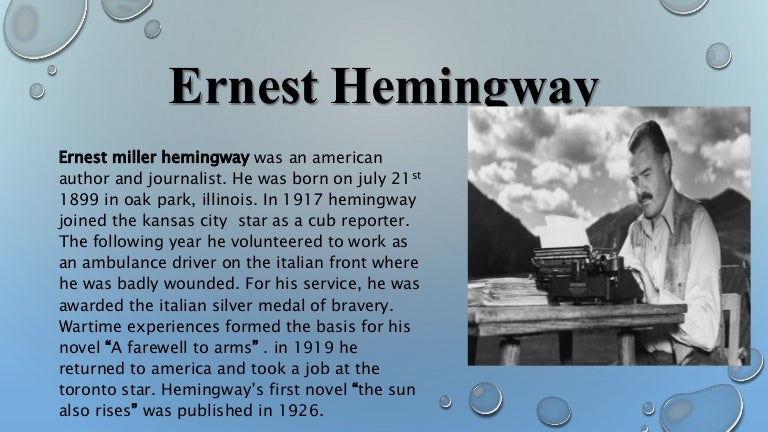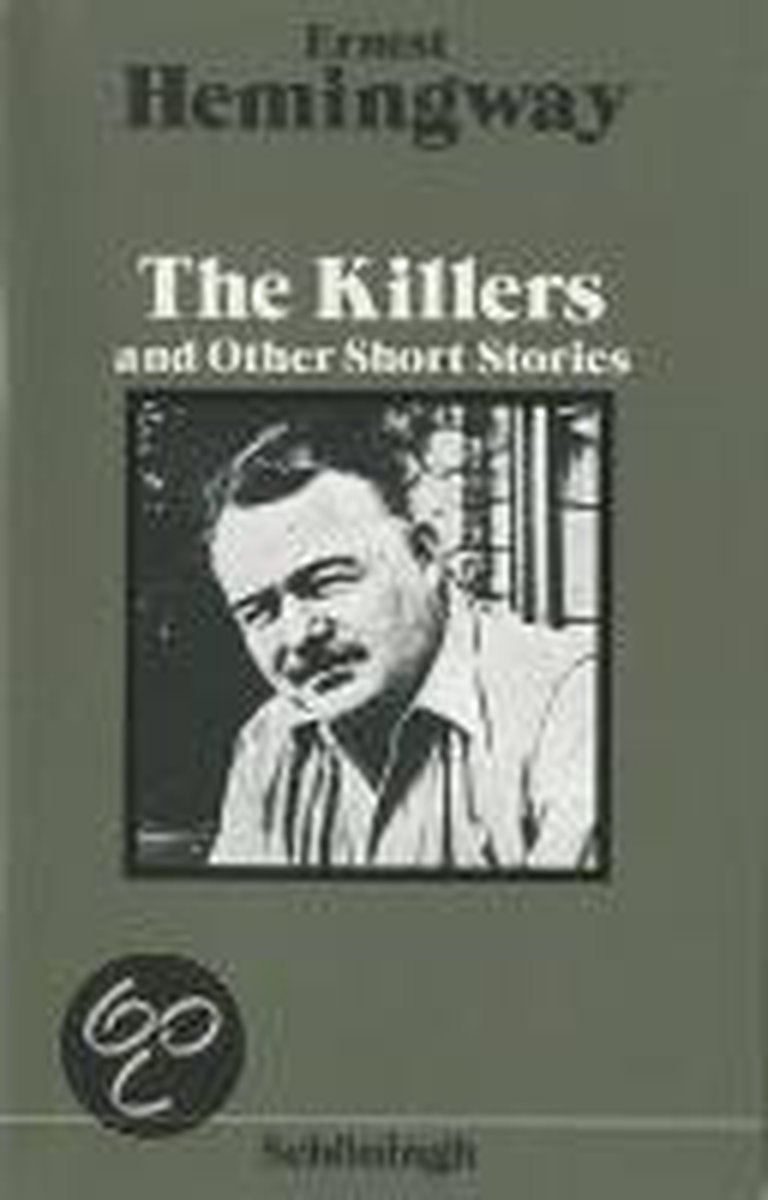
The Undefeated (dt. The Undefeated , translated by Anne Marie Horschitz-Horst ) is a short story by Ernest Hemingway , the first time from 1925 to 1926 the Parisian literary magazine in the autumn-winter edition of This Quarter appeared and 1927 in book form in the collection Men Without Women (dt. Men without women ) in New York was published.
The story is about an aging bullfighter who fights his last fight, and in Hemingway's early work depicts the hero who would later become typical for him, the “ Code Hero ”, in a life situation that is characteristic of him.
content
Manuel Garcia is already older, formerly famous bullfighter , who long after a serious injury in a bullfight and subsequent hospitalization time has not occurred more in the arena. He receives an offer from his former friend and sponsor Don Miguel Retana to take part in a bullfight one more time in an evening performance for a small fee. During the conversation, a photo in Retana's office reminds him of his brother, who was killed nine years earlier as a torero in a corrida . With no prospect of any other engagement, Garcia desperately accepts Retana's offer and seeks out his friend Zurito in a café to win him over as his picador for the fight. After an initial refusal, as he, as he says, already feels too old for another fight, Zurito finally agrees, out of old friendship, to support Garcia in the fight as a picador. Despite the disapproval and criticism from the younger matadors, who would like to perform in the arena themselves, Garcia and Zurito take on the fight against the bull in front of a bored audience. Garcia initially succeeds in irritating and successfully fighting the bull, although a reporter present in the audience is rather unimpressed by his performance as a torero. In the further course of the fight, however, Garcia is wounded several times by the bull and almost killed in a fight scene; he can only escape at the last second. Despite his own serious injuries, Garcia does not give up the fight and can ultimately deal the bull's death blow. Seriously injured, he is then carried out of the arena by the helpers and taken to a hospital accompanied by Zurito. Although Garcia, when he is already on the operating table, hopes to survive since no priest has been brought in, the outcome of the story remains open.
Biography of Ernest Hemingway 2. The Story of “The Undefeated“ III Main Part 1. The Main Theme 2. The Characterisation of Manuel Garcia 3. Pecularities of Hemingway’ s Style in “The Undefeated” 4. The Bullfight as Subject Matter 5. “The Undefeated“ as a Model for Hemingway’ s “The Old Man and the Sea“ IV Results. 'The Undefeated' is a short story by Ernest Hemingway featured in Hemingway's 1927 story collection, Men Without Women. The story deals with an ageing bullfighter’s return to the sport after an injury.
Interpretative approach
Hemingway succeeds, as Link emphasizes in his analysis, in artfully embedding a plot in the description of a situation in this story. Thematically, the plot of the short story is about Garcia's probation as a matador, a task that he is no longer physically up to due to his age. The introductory part of The Undefeated mainly serves to make this situation of the aging hero visible. For Garcia, bullfighting is not a profession that is only pursued to earn money; the point is to win the audience's favor through the test in the fight with the bulls, which, however, expires as soon as the test is no longer passed.
The scene in the café illustrates the humiliation that Garcia has to accept when the waiters only talk about the matador he is supposed to replace, but not about him. As can be seen from the previous history, he only received one engagement in the whole year; his stay in hospital shows that he has not passed his final test. Garcia sees the reason for this not in his own failure, but in the special nature of the bull in this fight. He is now hoping for the chance to prove himself again. As Link explains in his interpretation, the bullfight is “ paradigmatic for the existential self-assertion in this short story by Hemingway , which in the stage of aging and thus the decline of physical strength leads to a situation that is hopeless for the hero”.
What is striking in the narrative structure is the change in the different perspectives from which Garcia's situation is shown. Is z. For example, the perspective of the personal narrator initially focused on the presentation of Garcia's situation and prehistory and thereby largely summarized ( “telling” ). In the next section, this narrative perspective is neutralized by a predominantly dialogical form of presentation ( “showing” ). Retana appears as an observer, the reader learns nothing more than what he says to Garcia in the dialogue, but his point of view forms a contrasting background for that of the protagonist . This results in two different assessments of the situation. Garcia is in dire straits, unable to help but seek a chance of parole; Retana, on the other hand, shuts herself off from the torero's plight, his only concern is the financial.
The reporter, ironically also a substitute, has a special place in the short story. In addition to the doubts that Zurito has about the success of the fight, and to the assessment of the audience, which only recognizes the successful matador, there is now the contempt of the bullfighter in general. What determines the meaning of life for Garcia remains meaningless to the reporter as an outsider.
The motif of death introduced at the beginning of the story in the scene in Retana's office is no longer immediately taken up; the initial description of Garcia's first look at the bull that killed his brother, however, remains symbolically effective when the narrator describes how Garcia faces the bull in the arena at the beginning of the fight. The protagonist has to seek his test here by looking death in the eye. Garcia remains 'undefeated' in the sense that he does not evade. For him, life is 'a life leading to death and is determined solely by the combative assertion against it [ ie death ].'
Impact history
After its first publication in the Men Without Women collection, The Undefeated was initially very well received by American literary critics. For example, MR Rosene called this story the best American short story since Stephen Cranes' The Open Book was published . Nevertheless, The Undefeated received little attention for a long time in the subsequent literary examination of Hemingway's entire literary works and was forgotten. It was not until the early 1970s that the critical literary discussion in German-speaking countries once again emphasized the special importance of this short story in the work of the well-known American narrator.
With the development of the character of Garcia in The Undefeated (dt. The Undefeated ) the foundation is laid in Hemingway's early work for the subsequent design of written by him in Cuba and 1952 in Scribner's publisher in New York's world famous novel published The Old Man and the Sea (Eng. The old man and the sea ); the parallels between Garcia and Santiago, the protagonist in The Old Man and the Sea , are obvious. In The Old Man and the Sea , Hemingway also depicts the actual determination of life as a self-assertion and probation in the face of death, which the Hemingway hero fulfills with a relaxed and stoic attitude (cf. also Hemingway's concept of the ' Code Hero ')
German translation
Hemingway's short story collection Men Without Women , in The Undefeated ( The Undefeated ) is included, was of Anne Marie Horschitz-Horst translated into German and in 1929 under the title Men (1958, men without women ) in the Rowohlt Verlag published. Interestingly enough, in 1966 a license edition of the German translation was published by the Aufbau-Verlag in what was then the “ German Democratic Republic ” .

Others
The Undefeated (dt. The Undefeated ) was also in Hemingway's anthology The Fifth Column and the First Forty-Nine Stories (dt. 49 Stories , translated by Anne Marie Horschitz-Horst ) published for the first time in 1938 in Scribner's Verlag New York has been published. The text is available in various paperback editions.

literature
Undefeated Book Summary
- Franz H. Link: Hemingway • The Undefeated. In: Karl Heinz Göller et al. (Ed.): The American Short Story . August Bagel Verlag, Düsseldorf 1972, ISBN 3-513-02212-3 , pp. 288-297.
- Reiner Poppe: Ernest Hemingway · From the short story · Investigations and comments . Beyer Verlag Hollfeld / Ofr. 1978, ISBN 3-921202-40-X , pp. 25-35.
Web links

- The Undefeated . Full English text on Internet Archive . Retrieved October 11, 2013.
- The First Forty-Nine Stories Full English text on Internet Archive . Retrieved October 11, 2013.
The Undefeated Hemingway Pdf
Individual evidence
The Undefeated Hemingway Pdf
- ↑ See Carlos Baker: Hemingway - The Writer as Artist . Princeton University Press, 4th ed. 1972, ISBN 0-691-01305-5 , p. 418. See also Hemingway and The Magazines . On: University Libraries South Carolina . Retrieved May 26, 2015.
- ^ A b c See Franz H. Link: Hemingway • The Undefeated. In: Karl Heinz Göller et al. (Ed.): The American Short Story . August Bagel Verlag, Düsseldorf 1972, ISBN 3-513-02212-3 , p. 288. In the collection The Essential Hemingway , first published in Great Britain in 1947 by Jonathan Cage , which was later reissued in various paperback editions by the Random House publishing group, however 1928 named as the year Men Without Women was first published.
- ↑ See Franz H. Link: Hemingway • The Undefeated. In: Karl Heinz Göller et al. (Ed.): The American Short Story . August Bagel Verlag, Düsseldorf 1972, ISBN 3-513-02212-3 , p. 289.
- ↑ See Franz H. Link: Hemingway • The Undefeated. In: Karl Heinz Göller et al. (Ed.): The American Short Story . August Bagel Verlag, Düsseldorf 1972, ISBN 3-513-02212-3 , p. 290.
- ^ Franz H. Link: Hemingway • The Undefeated. In: Karl Heinz Göller et al. (Ed.): The American Short Story . August Bagel Verlag, Düsseldorf 1972, ISBN 3-513-02212-3 , p. 292.
- ↑ See in detail Franz H. Link: Hemingway • The Undefeated. In: Karl Heinz Göller et al. (Ed.): The American Short Story . August Bagel Verlag, Düsseldorf 1972, ISBN 3-513-02212-3 , p. 292f.
- ^ Franz H. Link: Hemingway • The Undefeated. In: Karl Heinz Göller et al. (Ed.): The American Short Story . August Bagel Verlag, Düsseldorf 1972, ISBN 3-513-02212-3 , p. 294f.
- ^ Franz H. Link: Hemingway • The Undefeated. In: Karl Heinz Göller et al. (Ed.): The American Short Story . August Bagel Verlag, Düsseldorf 1972, ISBN 3-513-02212-3 , pp. 295-297f.
- ↑ MR Rosene: The Five Best American Books Published since 1900 '.. In: Writer. 46, 1934: 370f.
- ↑ On Hemingway's concept of the “code hero” cf. also the (English) remarks on: 'Lost Generation' . Retrieved October 11, 2013.
- ↑ Hemingway, Ernest, Horschitz-Horst, Annemarie: Men without women: stories / Ernest Hemingway . Authorized translation from the American by Annemarie Horschitz-Horst, Aufbau-Verlag, Berlin, Weimar 1966.